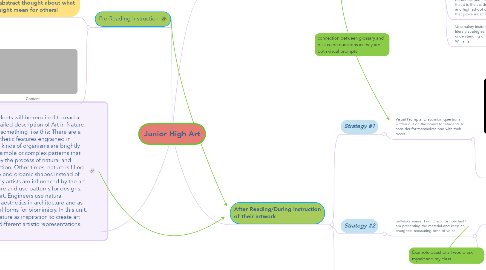
1. Pre-Reading Instruction
1.1. For pre-reading I would connect the last unit of work to art in nature and talk about how elements of that unit are directly related to nature that we may not have noticed. I would show the following video to start some abstract thought about what art in nature might mean for others!
1.1.1. Next, I would verabally introduce the first activity that students will gather nature materials from outside to construct into an object or sculpture. To go along with the verbal introduction, I will also provide a work sheet with some prompts for ideas and brainstorming.
1.1.2. This provides an opportunity to teach students to make predictions consciously before reading. The ELL intervention framework describes when "students make predictions before reading, they must recall what they know about the type of text to be read and anything they might know about the specific text or the topic it covers. Making predictions before reading also gives students an opportunity to check, and reflect on, their predictions while reading as well as after reading (pg, .
1.2. Content
2. Reading: students will be required to read a complex, detailed description of Art in Nature. Might sound something like this: There are a variety of aesthetic features engrained in nature. Many kinds of organisms are brightly colored with simple or complex patterns that are created by the process of natural and artificial selection. Other times, nature is filled with asymetry and organic shapes instead of patterns. Many artists are influenced by the art found in nature and use patterns for designs, fashion and art. Engineers use natural structures for aesthetics in architecture and as well as natural forms for biomimicry. In this unit, we will use nature as inspiration to create art and explore different artistic representations.
3. After Reading/During Instruction of their artwork
3.1. Strategy #1
3.1.1. Visual Prompts: Discussion questions written out on the board for students to consider for themselves and with their peers.
3.1.1.1. Visual Prompts: Images on the projector playing as a slideshow that displays art, pattern, and colour in nature along student examples of this assignment. This visual prompt can also include a group mind map or venn diagram that describes the classes ideas on "art in nature."
3.1.1.1.1. WHY this will support student comprehension:
3.2. Strategy #2
3.2.1. Self-Awareness: I will check for how fast I am presenting the material and keep an energetic, reassuring tone of voice.
3.2.1.1. Keep checking for student understanding of any tricky vocabulary I may have used. Go around and provide individual feedback or help with any misunderstandings student may have with my directions or expectations. Ask myself if I have answered their questions in a way that makes sense to them, not just myself.
3.2.1.1.1. WHY this will support student comprehension:
3.2.1.2. "Wait, do they know that term I just used?"
3.2.1.2.1. "Am I being too quiet?"
3.2.1.2.2. "Is my tone of voice calm right now or kind of aggressive since I'm having a bad day?"
3.2.1.2.3. "Does everyone understand what that person just meant?"
3.3. Strategy #3
3.3.1. Experimentation: I will provide room for experimentation, personal voice, and interpretation of the assignment so that students feel safe following their ideas and intuition. This can be provided in the form of a Semantic Map.
3.3.1.1. The Semantic Map encourages brainstorming and new ideas to come into play. Meanwhile, new and alternative supplies can be provided to experiment with. I would show this video to help describe this activity.
3.3.1.1.1. WHY this will support student comprehension:
4. During Reading
4.1. Provide a glossary of key terms for students to look over as they read the provided text.
4.1.1. WHY this will support student comprehension:
4.1.1.1. Academic language is identified as "an area of weakness" and the reading may be filled with words and meaning that some students do not understand (ELL interventions, pg.16).
4.1.1.2. "K-12 classrooms across the nation must increase opportunities for ELLs to develop sophisticated vocabulary knowledge (ELL interventions pg. 20)."
4.1.1.3. The ELL interventions framework would agree that a provided glossary helps because "vocabulary instruction rarely occurs despite the fact that it is the academic language of middle and high school classrooms and texts that prove most difficult (pg. 20)."
4.1.1.4. Vocabulary instruction is one of the seven literary strategies that increases student understanding of content (Fischer, Frey, Williams).
